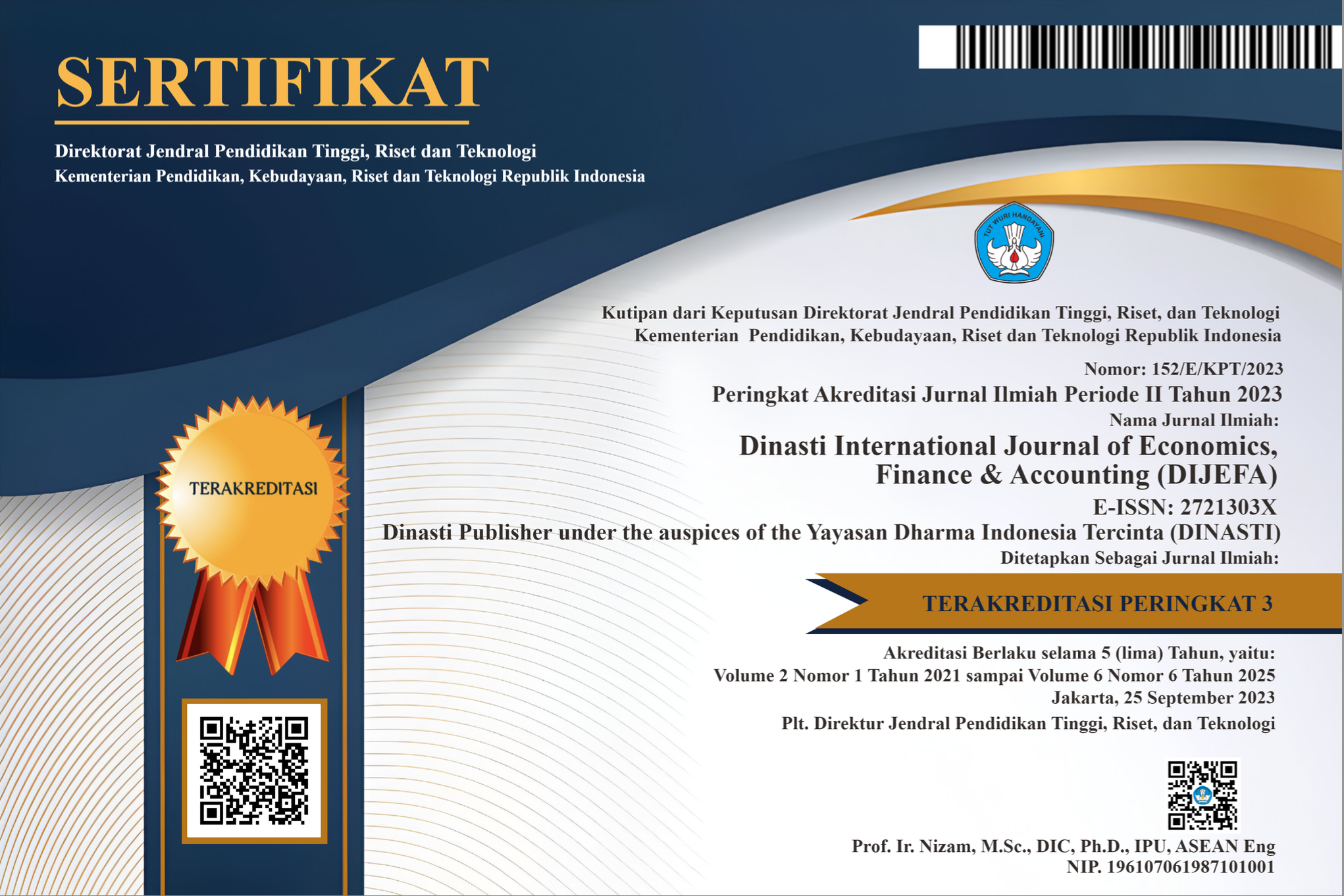Business Network Literature Review: A Mini-Review Approach
DOI:
https://doi.org/10.38035/dijefa.v2i1.797Keywords:
Business networks, small and medium enterprises, Clustering social audiences in business information networks.Abstract
This study aims to find the formulation of factors that can influence the development of business networks both locally and globally. This study used a qualitative method by reviewing 27 journals from previous researchers. The results of this study indicate that multi-actor factors are useful for understanding business networks. Ex-ante signaling and filtering factors at the contractual relationship formation stage are complementary mechanisms that enhance network performance. Agency approach, structure approach and practice approach affect the performance of the business network. Another factor that can improve the performance of a business network is clustering social audiences in a business information network. Organizational variables such as participatory architecture, organizational integration, and mechanisms play a relevant role in protecting and developing business networks. The next finding is that the management relationship factor can improve the performance of the small and medium business network. Value creation innovation includes new capabilities, technology and processes as well as partnerships for the purpose of co-creation that can reduce risk in the business network. Linkage factors and their effect on network connectivity can play a relevant role in strategic business decisions. The role of dynamic capabilities in encouraging business model innovation, especially in market-oriented small and medium enterprises, can encourage innovation in the business model of the small and medium enterprises themselves. Other factors that can affect the efficiency of a business network are intellectual agility, leadership and micro-enterprise innovation mediated through entrepreneurial leadership. The large structure in a business network can positively affect business performance through linkage mechanisms. Whereas the presence of a large number of affiliates in the first company layer of the affiliate structure causes a decrease in the effect of size on the group level performance of the business. Limited diversification at the business group level in the first corporate layer of the affiliate structure results in reduced returns in terms of risk sharing, because shareholders can reduce their investment, thus negatively impacting the overall group level performance. The role of religion and spirituality in the context of a business network greatly influences the strength of a business network.
References
Andres Layaa, Jan Markendahla, Stefan Lundberg. (2018). Network-centric business models for health, social care and wellbeing solutions in the internet of things . Scandinavian Journal of Management , 34: 103–116/Received in revised/https://doi.org/10.1016/j.scaman.2018.02.004.
Carlos Rodriguez, Jose Torres. (2020). Central coordination and profitability in large Latin American business groups. Journal of Business Research, 119 - 599–609,Elsevier Inc. All rights reserved.https://doi.org/10.1016/j.jbusres.2020.07.007.
Cheng Lu Wanga, Henry F.L. Chung. (2020). Business networking and innovation of Asian enterprises in Western countries: The moderation of institutional distance. Industrial Marketing Management, 88 : 152–162.
Dr. Viera Spanikova, Laura Birkman, Corine Besseling. (2014). Business Networks.Final report. . Rotterdam: Ecorys.
Du Jian, Xu Yue, Hinrich Voss, Wang Song. (2019). The impact of home business network attributes on Chinese outward foreign direct investment. International Business Review, Elsevier Ltd. All rights reserved.
Farhad Sadeh, Manish Kacker. (2020). Performance implications of using signaling and screening for expanding interfirm business networks: Evidence from franchising. Industrial Marketing Management, 88/ 47–58/Elsevier Inc. All/https://doi.org/10.1016/j.indmarman.2020.04.008.
Ford, David, Lars-Erik Gadde, and Håkan Håkansson. (2003). Managing business relationships.
Francesca Ricciardi, Alessandro Zardini, Cecilia Rossignoli. (2018). Business network commons and their fragilities: Emerging configurations of local organizational fields. Journal of Business Research , 89: 328–335.Elsevier Inc/https://doi.org/10.1016/j.jbusres.2018.01.005.
Franziska S. Kullaka,Jonathan J. Baker, Herbert Woratscheka. (2021). Enhancing value creation in social purpose organizations: Business models that leverage networks. Journal of Business Research, 125: 630–642.Elsevier Inc. All rights reserved.https://doi.org/10.1016/j.jbusres.2020.01.069.
Ilkka Ojansivua,Jan Hermes,c, Sari Laari-Salmela. (2020). Business relationships in the industrial network literature: Three approaches and their underlying assumptions. Industrial Marketing Management, 87 - 181–195/Elsevier Inc.https://doi.org/10.1016/j.indmarman.2019.11.016.
Jordan Robert Gamble , Eric Clinton, Vanessa Díaz-Moriana. (2020). Broadening the business model construct: Exploring how family-owned SMEs co-create value with external stakeholders. Journal of Business Research , Elsevier Inc. All rights reserved/https://doi.org/10.1016/j.jbusres.2020.03.034.
Julia A. FehJulia A. Fehrera, Heiko Wieland. (2021). A systemic logic for circular business models. Journal of Business Research , 125: 609–620125.Elsevier Inc. All rights reserved.https://doi.org/10.1016/j.jbusres.2020.02.010.
Krithika Randhawa, Ralf Wilden, Siegfried Gudergan. (2020). How to innovate toward an ambidextrous business model? The role of dynamic capabilities and market orientation. Journal of Business Research, Elsevier Inc. All rights reserved./https://doi.org/10.1016/j.jbusres.2020.05.046.
Line Blander Reinhardt, David Pisinger, Mikkel M. Sigurd, Jonas Ahmt. (2020). Speed optimizations for liner networks with business constraints . European Journal of Operational Research , 285 :1127–1140.ElsevierB.V.Allrightsreserved.https://doi.org/10.1016/j.ejor.2020.02.043.
Maria M. Smirnova. (2020). Managing business and social network relationships in Russia: The role of relational capabilities, institutional support and dysfunctional competition. Industrial Marketing Management, 9/ 340–354,Elsevier Inc..https://doi.org/10.1016/j.indmarman.2020.02.008.
Marina Amado Bahia Gama, Rodrigo Bandeira-de-Mello. (2021). The effect of affiliation structure on the performance of pyramidal business groups. Journal of Business Research , 124:24–37.Elsevier Inc. All rights reserved.https://doi.org/10.1016/j.jbusres.2020.11.041.
Marina Dabi, Neboj?sa Stojcic, Marijana Simic, Vojko Potocan, Marko Slavkovic. (2021). Intellectual agility and innovation in micro and small businesses: The mediating role of entrepreneurial leadership Zlatko Nedelko. Journal of Business Research, 123- 683–695.Elsevier Inc. All rights reserved.https://doi.org/10.1016/j.jbusres.2020.10.013.
Matteo Cinelli. (2020). Ambiguity of network outcomes. Journal of Business Research , Elsevier Inc. All rights reserved/https://doi.org/10.1016/j.jbusres.2020.02.031.
Meng Li. (2020). Did the small business administration’s COVID-19 assistance go to the hard hit firms and bring the desired relief? Journal of Economics and Business, Elsevier Inc. All rights reserved.https://doi.org/10.1016/j.jeconbus.2020.105969.
Michael Czinkota, Zaheer Khan, Gary Knight. ( 2021). International business and the migrant-owned enterprise . Journal of Business Research, 122- 657–669.Published by Elsevier Inc.https://doi.org/10.1016/j.jbusres.2020.07.049.
Roy Cerqueti , Gian Paolo Clemente , Rosanna Grassi. (2020). Stratified cohesiveness in complex business networks . Journal of Business Research, Elsevier Inc. All rights reserved./https://doi.org/10.1016/j.jbusres.2020.04.005.
Samuel Adomako, Joseph Amankwah-Amoah, Shlomo Y. Tarba , Zaheer Khan. (2020). Perceived corruption, business process digitization, and SMEs’ degree of internationalization in sub-Saharan Africa. Journal of Business Research, 123- 196–207.
Tuomas Ahola,Kirsi Aaltonen, Karlos Artto, Jere Lehtinen. ( 2020). Making room to manoeuvre: How firms increase their influence with others. Industrial Marketing Management, 91.686–700.
Valtteri Kaartemo,Nicole Coviello, Niina Nummela. (2020). A kaleidoscope of business network dynamics: Rotating process theories to reveal network microfoundations. Industrial Marketing Management, 91 -657–670.
Yu Zheng a , Ruiqi Hu , Sai-fu Fung, Celina Yu, Guodong Long, Ting Guo, Shirui Pan. (2020). Clustering social audiences in business information networ. Pattern Recognition , 100-107126/ElsevierLtd.https://doi.org/10.1016/j.patcog.2019.107126.
Yusuf Kurta,Noemi Sinkovics, Rudolf R. Sinkovic, Mo Yamin. (2020). The role of spirituality in Islamic business networks: The case of internationalizing Turkish SMEs. Journal of World Business , 55 : 101034.Published by Elsevier Inc.https://doi.org/10.1016/j.jwb.2019.101034.
Downloads
Published
How to Cite
Issue
Section
License
Authors who publish their manuscripts in this journal agree to the following conditions:
- The copyright on each article belongs to the author(s).
- The author acknowledges that the Dinasti International Journal of Economics, Finance & Accounting (DIJEFA) has the right to be the first to publish with a Creative Commons Attribution 4.0 International license (Attribution 4.0 International (CC BY 4.0).
- Authors can submit articles separately, arrange for the non-exclusive distribution of manuscripts that have been published in this journal into other versions (e.g., sent to the author's institutional repository, publication into books, etc.), by acknowledging that the manuscript has been published for the first time in the Dinasti International Journal of Economics, Finance & Accounting (DIJEFA).


























































